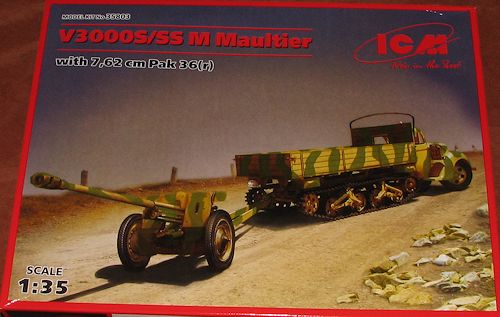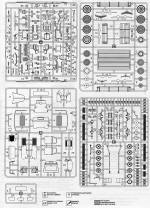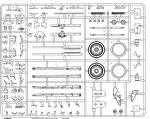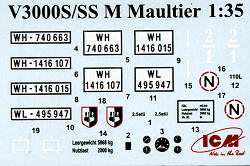
| HISTORY |
| KIT #: | 35803 |
| PRICE: | $51.99 SRP |
| DECALS: | Four options |
| REVIEWER: | Scott Van Aken |
| NOTES: |

| HISTORY |
The Ford V3000 was used extensively by German forces in WWII, being manufactured throughout the war by the German operation of the Ford Motor Company, Ford-Werke, in Cologne. This was one of the most numerous of the various 3ton trucks used by the Wehrmacht during WII. The truck was equipped with the flathead V8 that made Ford famous pre war and was the engine of choice by many early post war hot rodders in the US.
Since this truck was rear drive only, its off road performance was quite poor and so it was the basis of a Maultier half track. This vehicle was used on every front where the Germans fought. Some of theses tracked vehicles were used post war and others were converted back to standard truck configuration.
The 7.62 cm FK 36(r) and Pak 36(r) (7.62 cm Feldkanone (Field gun)/36 (russisch) and Panzerabwehrkanone (Anti-tank gun) 36(russisch)) were German anti-tank guns used by the Wehrmacht in World War II. The gun was a conversion of the Soviet 76-mm divisional gun M1936 (F-22) and the later 76 mm divisional gun M1939 (USV) and 76 mm divisional gun M1942 (ZiS-3).
| THE KIT |

 This particular boxing is a real bargain for the armor fan. You not only get the earlier V3000S/SS M Maultier kit but also a very nice PaK 36(r), all for a few dollars less in terms of SRP than the Maultier kit alone. Nothing has changed in terms of the sprues and details for either kit, so I'll simply repeat what was earlier stated for the Maultier.
This particular boxing is a real bargain for the armor fan. You not only get the earlier V3000S/SS M Maultier kit but also a very nice PaK 36(r), all for a few dollars less in terms of SRP than the Maultier kit alone. Nothing has changed in terms of the sprues and details for either kit, so I'll simply repeat what was earlier stated for the Maultier.
The PaK 36(r) is equally as well detailed and molded as the Maultier kit. ICM have improved a great deal since their early days in terms of quality control and parts detailing, putting them up there with the rest of the armor kit makers. The field gun can be moved in both elevation and in azimuth. It can also be built being towed or with the trails spread for action. There are several rounds included with this part of the kit.
As you can see from the sprues diagram, ICM pretty much gives you the basic truck kit and adds in a sprue for the new rear drive. You get a very nicely detailed flathead Ford V-8 and this fits into a chassis that is built up of separate main frames and crossover pieces. The front wheels are attached in a method that has you put the inner wheel bit onto the spindle and then it is held in place by a large cap. The theory being that the wheel will turn. You then put the outer wheel/tire onto it. I am sure that many of us will simply glue it all solid.
The cab and hood section are made up of several sections. The interior of the cab is well appainted with separate pedals and a nicely done dash. Decals are provided for the instruments. It does not seem to me that the hood can be displayed open as there is no hinge mechanism. However, you can simply lay it in place to show off the engine if you should so desire.
The rear box is made up of a separate floor and sides. There are cross pieces to allow the bed to fit onto the frame when it is finished. I am sure you could drop the rear gate or leave off the rear and sides if you wanted to do a flatbed version. The rear track assembly is nicely detailed and it consists of link and length tracks, which I know many would rather have in place of individual links or 'rubber band' tracks. This offers the detail of separate links for going around the sprocket and idler wheels with the ease of having all the straight sections pre-assembled.
 ICM instructions are very nice, consisting of well drawn construction steps on slick paper. Generic and Model Master paint information is provided with any in-work painting information provided, unlike some kit makers. There are four options provided with no unit information provided for any. One is overall panzer tan based in Germany in 1943. Another is in overall panzer grey, also based in Germany during 1943. Next is a tan truck based in Poland during 1944 with large green splotches on it. The instructions show the camouflage only on a section of the vehicle. With a fine green camo is the last one from Italy in 1944. The nicely done decal sheet provides basically license plates, though the Italian option has unit markings of some sort as well. The field gun has no decals, and the markings guide offers a variety of schemes. The gun also has its own set of instructions.
ICM instructions are very nice, consisting of well drawn construction steps on slick paper. Generic and Model Master paint information is provided with any in-work painting information provided, unlike some kit makers. There are four options provided with no unit information provided for any. One is overall panzer tan based in Germany in 1943. Another is in overall panzer grey, also based in Germany during 1943. Next is a tan truck based in Poland during 1944 with large green splotches on it. The instructions show the camouflage only on a section of the vehicle. With a fine green camo is the last one from Italy in 1944. The nicely done decal sheet provides basically license plates, though the Italian option has unit markings of some sort as well. The field gun has no decals, and the markings guide offers a variety of schemes. The gun also has its own set of instructions.
| CONCLUSIONS |
It is nice to see a double kit like this one. I think that offering a gun and prime mover is a great idea and hope that we will see other offerings like this one.
| REFERENCES |
http://en.wikipedia.org/wiki/PaK_36%28r%29
Kit instructions
July 2013
Thanks to Squadron Products for the preview kit. You can find this kit at your favorite hobby shop or on-line retailer.
If you would like your product reviewed fairly and fairly quickly, please contactthe editor or see other details in the